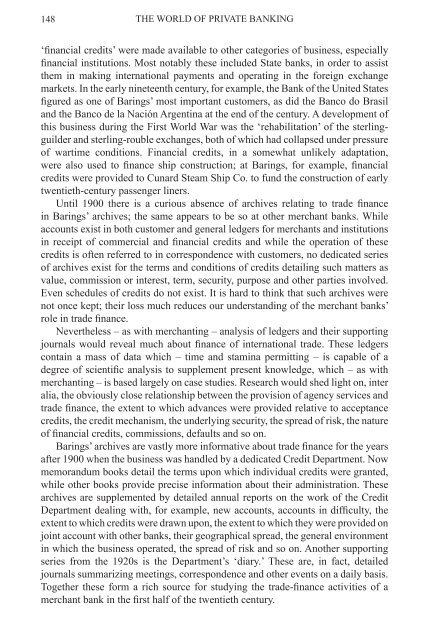the world of private banking
the world of private banking
the world of private banking
You also want an ePaper? Increase the reach of your titles
YUMPU automatically turns print PDFs into web optimized ePapers that Google loves.
148<br />
THE WORLD OF PRIVAtE BANKING<br />
‘financial credits’ were made available to o<strong>the</strong>r categories <strong>of</strong> business, especially<br />
financial institutions. Most notably <strong>the</strong>se included State banks, in order to assist<br />
<strong>the</strong>m in making international payments and operating in <strong>the</strong> foreign exchange<br />
markets. In <strong>the</strong> early nineteenth century, for example, <strong>the</strong> Bank <strong>of</strong> <strong>the</strong> United States<br />
figured as one <strong>of</strong> Barings’ most important customers, as did <strong>the</strong> Banco do Brasil<br />
and <strong>the</strong> Banco de la Nación Argentina at <strong>the</strong> end <strong>of</strong> <strong>the</strong> century. A development <strong>of</strong><br />
this business during <strong>the</strong> First World War was <strong>the</strong> ‘rehabilitation’ <strong>of</strong> <strong>the</strong> sterlingguilder<br />
and sterling-rouble exchanges, both <strong>of</strong> which had collapsed under pressure<br />
<strong>of</strong> wartime conditions. Financial credits, in a somewhat unlikely adaptation,<br />
were also used to finance ship construction; at Barings, for example, financial<br />
credits were provided to Cunard Steam Ship Co. to fund <strong>the</strong> construction <strong>of</strong> early<br />
twentieth-century passenger liners.<br />
Until 1900 <strong>the</strong>re is a curious absence <strong>of</strong> archives relating to trade finance<br />
in Barings’ archives; <strong>the</strong> same appears to be so at o<strong>the</strong>r merchant banks. While<br />
accounts exist in both customer and general ledgers for merchants and institutions<br />
in receipt <strong>of</strong> commercial and financial credits and while <strong>the</strong> operation <strong>of</strong> <strong>the</strong>se<br />
credits is <strong>of</strong>ten referred to in correspondence with customers, no dedicated series<br />
<strong>of</strong> archives exist for <strong>the</strong> terms and conditions <strong>of</strong> credits detailing such matters as<br />
value, commission or interest, term, security, purpose and o<strong>the</strong>r parties involved.<br />
Even schedules <strong>of</strong> credits do not exist. It is hard to think that such archives were<br />
not once kept; <strong>the</strong>ir loss much reduces our understanding <strong>of</strong> <strong>the</strong> merchant banks’<br />
role in trade finance.<br />
Never<strong>the</strong>less – as with merchanting – analysis <strong>of</strong> ledgers and <strong>the</strong>ir supporting<br />
journals would reveal much about finance <strong>of</strong> international trade. These ledgers<br />
contain a mass <strong>of</strong> data which – time and stamina permitting – is capable <strong>of</strong> a<br />
degree <strong>of</strong> scientific analysis to supplement present knowledge, which – as with<br />
merchanting – is based largely on case studies. Research would shed light on, inter<br />
alia, <strong>the</strong> obviously close relationship between <strong>the</strong> provision <strong>of</strong> agency services and<br />
trade finance, <strong>the</strong> extent to which advances were provided relative to acceptance<br />
credits, <strong>the</strong> credit mechanism, <strong>the</strong> underlying security, <strong>the</strong> spread <strong>of</strong> risk, <strong>the</strong> nature<br />
<strong>of</strong> financial credits, commissions, defaults and so on.<br />
Barings’ archives are vastly more informative about trade finance for <strong>the</strong> years<br />
after 1900 when <strong>the</strong> business was handled by a dedicated Credit Department. Now<br />
memorandum books detail <strong>the</strong> terms upon which individual credits were granted,<br />
while o<strong>the</strong>r books provide precise information about <strong>the</strong>ir administration. These<br />
archives are supplemented by detailed annual reports on <strong>the</strong> work <strong>of</strong> <strong>the</strong> Credit<br />
Department dealing with, for example, new accounts, accounts in difficulty, <strong>the</strong><br />
extent to which credits were drawn upon, <strong>the</strong> extent to which <strong>the</strong>y were provided on<br />
joint account with o<strong>the</strong>r banks, <strong>the</strong>ir geographical spread, <strong>the</strong> general environment<br />
in which <strong>the</strong> business operated, <strong>the</strong> spread <strong>of</strong> risk and so on. Ano<strong>the</strong>r supporting<br />
series from <strong>the</strong> 1920s is <strong>the</strong> Department’s ‘diary.’ These are, in fact, detailed<br />
journals summarizing meetings, correspondence and o<strong>the</strong>r events on a daily basis.<br />
Toge<strong>the</strong>r <strong>the</strong>se form a rich source for studying <strong>the</strong> trade-finance activities <strong>of</strong> a<br />
merchant bank in <strong>the</strong> first half <strong>of</strong> <strong>the</strong> twentieth century.












![[Pham_Sherisse]_Frommer's_Southeast_Asia(Book4You)](https://img.yumpu.com/38206466/1/166x260/pham-sherisse-frommers-southeast-asiabook4you.jpg?quality=85)



